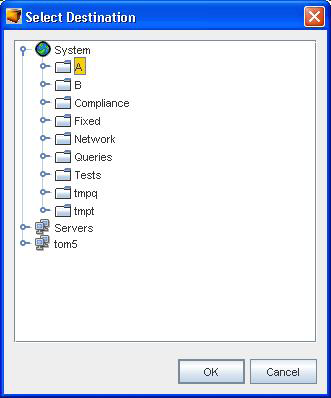The automation library was extensively revised in the Network Configuration Manager 4.1.1 release. It is sub-divided into folders, which may contain folders or the various Automation Library objects, which include:
Queries – Attributed Model queries are templates that define database searches of the Data Model objects.
Attributed Compliance Tests – a compliance test based on a Query of the Attributed Model and a set of rules to determine if the result set is compliant.
Regular Expression Compliance Tests – a compliance test constructed using regular expression matching and substitutions applied to a textual configuration file or diagnostic output.
Templates – a body of text (containing variables) which can be pushed to the device to make a configuration change.
Data Files – a spreadsheet-like definition of a set of variables and their values for each Device. Template variables can be resolved using the values from a Data File before the Template is pushed to the Device.
Saved Commands – a body of text (containing variables) which can be pushed to the device as a set of commands.
Standards – a definition of a collection of compliance tests, each of which can be applied against one or more Device classes, that represent a standard that can be audited for compliance. Standards can contain a mixture of Attributed and Regular Expression compliance tests.
Policies – a definition of a collection of standards that should be enforced (via compliance auditing) when a Device’s configuration changes in a Network, View, or Workspace.
At the top level, the Automation Library contains a “System” folder, which is accessible only to users with System Administration privilege; a “Samples” folder, which is accessible to all users but whose (recursive) content is read-only; and a folder for each network defined in the system, such as “Network1” where that name corresponds to the name of a network. Within these folders other folders can be created, allowing a complex path hierarchy to be developed. Each folder can hold any type of automation library object.
The “Samples” folder is sub-divided into the folders “Compliance”, “Queries”, “Saved Commands”, and “Templates”, each of which contains read-only examples corresponding to the name of the folder. “Compliance” is further divided into “Attributed Tests” and “ciscoIosCompliance”. “Queries” is further divided into “Finders” and “OSPF”. The user may not add additional items to one of the Samples folders; they folders and all items in them are read-only.
In order to modify an item in the “Samples” folder hierarchy or to link a Compliance Test in the hierarchy to a standard, it must first be copied to a folder in either the “System” folder hierarchy, or one of the network folder hierarchies. This is enforced so that Network Configuration Manager can update the sample library without impacting any changes or dependencies introduced by users. An updated sample library can be installed without re-installing or updating Network Configuration Manager, or even restarting the Network Configuration Manager server.
To copy an automation library item to a new folder, right click the item in the Automation Library tree, select “Copy”, and then select the destination folder from a pop-up folder hierarchy, as illustrated in Selection Destination dialog box.
